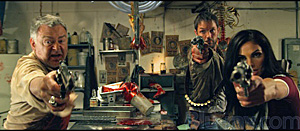Fri 24 Feb 2017
A TV Series Review by Michael Shonk: RUN, BUDDY, RUN (1966-67).
Posted by Steve under Reviews , TV Comedy[12] Comments
RUN, BUDDY, RUN. CBS, 1966-67. Talent Associates in association with CBS Television Studios. Cast: Jack Sheldon as Buddy Overstreet, Bruce Gordon as Mr. D. and Jim Connell as Junior. Created by Leonard Stern. Theme by Jerry Fielding.
Successful TV producer Leonard Stern produced both the successful spy spoof Get Smart, and The Fugitive spoof Run, Buddy, Run. The two series were much alike but with very different results. Get Smart would become on of TV’s most memorable series, while Run, Buddy, Run has been long forgotten.
Jazz musician Buddy Overstreet (Jack Sheldon) accidentally overhears a mob boss (Bruce Gordon) discuss “Operation Chicken Little,†a plan to kill an unnamed person. Buddy is discovered and makes a run for it. With the mob close behind, Buddy runs from town to town looking for a place he can be safe or until he can find out more about “Chicken Little†and prove to the cops he needs protection.
Jack Sheldon began as a successful trumpet player in the West Coast jazz movement during the 1950s. He was a regular on The Merv Griffin Show for many years. Shelton has worked as a singer. He sang for the ABC-TV series Schoolhouse Rock (“Conjunction Junction” and “I’m Just a Bill”). He has done voice work on The Simpsons and Family Guy. There is a documentary about him, Trying to Get Good: The Jazz Odyssey of Jack Sheldon.
A better musician than actor, Sheldon has appeared on old forgotten series The Cara Williams Show and The Girl with Something Extra. On Run, Buddy, Run, Sheldon makes Buddy likeable and an average guy the audience can root for, but he is not good enough to rise above the hit-and-miss writing.
The series villain was well cast. Bruce Gordon a successful character actor best known as Frank Nitti in The Untouchables (1959-1963) played Mr. D., the head of the mob. At his side was his young son Junior played well by Jim Connell.
Run, Buddy, Run could not outrun a quick cancellation but lasted long enough to air thirteen episodes. Airing Monday at 8:00 -8:30pm, Buddy would finish last in the ratings versus NBC’s I Dream of Jeannie and the last half-hour of ABC’s Iron Horse. It didn’t help that the three series that followed Buddy in CBS’s Monday night lineup — The Lucy Show, The Andy Griffith Show and Family Affair – finished in the top 15 for ratings.
“Steambath and Chicken Little.†(9/12/66) Written by Mel Tolkin and Ernie Chambers. Directed by Leonard Stern. Produced by David Susskind, David Melnick and Leonard Stern. Guest Cast: Bernie Kopell, Malcolm Atterbury, and Laurel Goodwin. *** Jazz musician Buddy Overstreet accidently overhears plans for a mob hit but is discovered. He escapes and now is on the run from the mob that wants him dead.
On the run, he ends up in Rockford, Illinois helping a nice young woman and her sick father try to save their gas station from bankruptcy.
Part One:
Part Two:
Part Three:
The humor had its moments but was more often ruined by a lack of believability. While Get Smart is much better, Run, Buddy, Run is a good example of the silly stupid humor of the American TV comedy in the 60s.
You can read more about the series at the TVParty website:
http://www.tvparty.com/recrunbuddy.html
